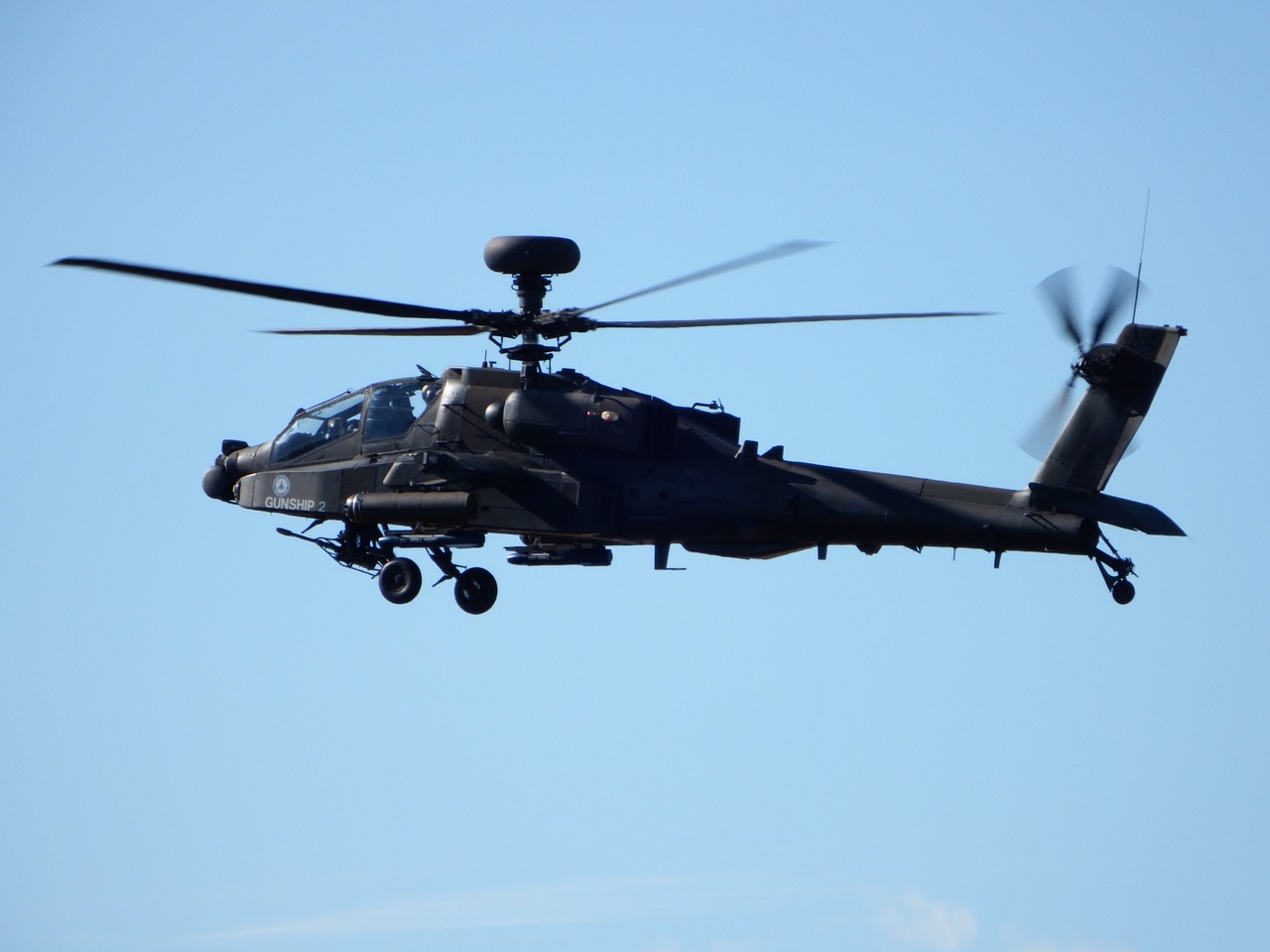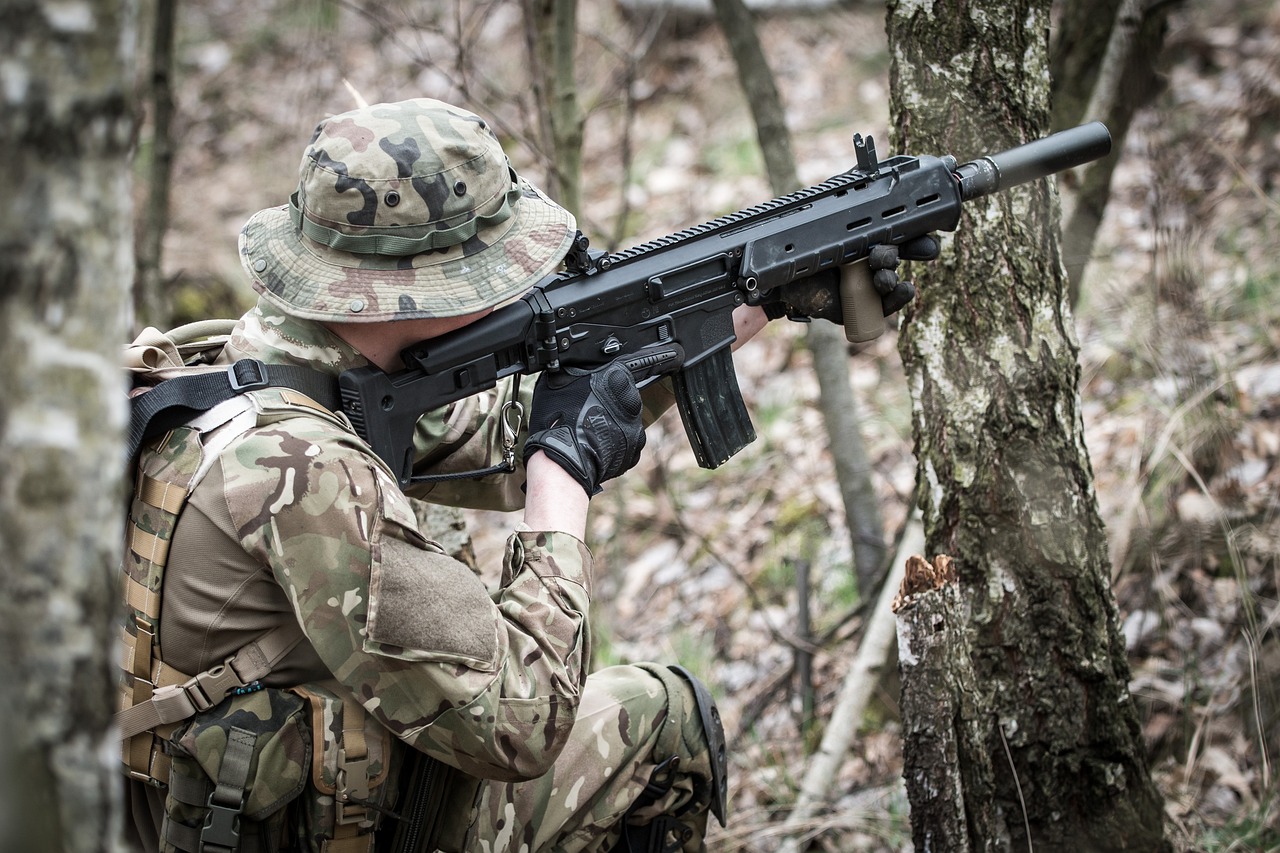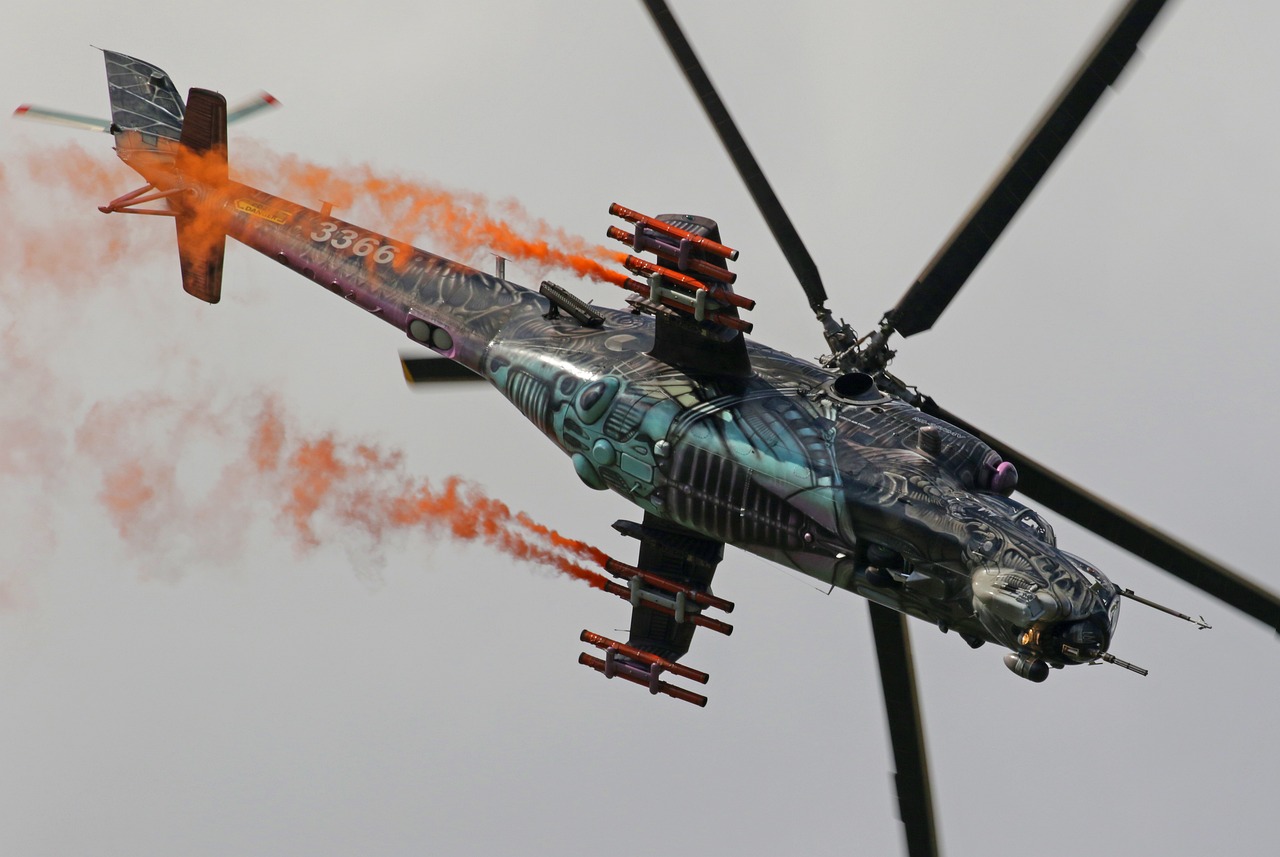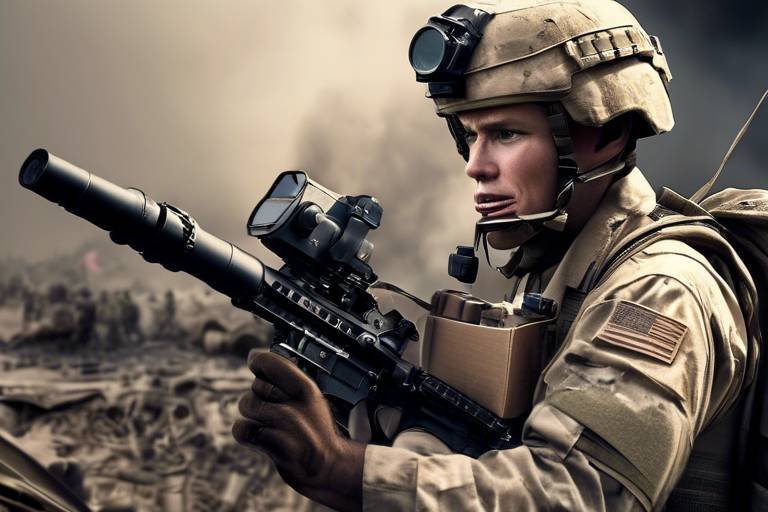The Potential of AI in Enhancing Combat Readiness
In today's rapidly evolving military landscape, the integration of artificial intelligence (AI) is proving to be a game-changer. Imagine a battlefield where decisions are made not just by humans, but with the assistance of advanced algorithms that analyze vast amounts of data in real-time. This is not science fiction; this is the reality of modern warfare. AI is revolutionizing military operations, making them more efficient and effective, and ultimately boosting combat readiness.
The potential of AI in enhancing combat readiness is immense. It allows military leaders to harness the power of data analytics to make informed decisions, improve training protocols, and streamline logistics. By leveraging AI, military organizations can ensure that their personnel are not just prepared for combat, but are also equipped with the tools and knowledge needed to adapt to any situation they might face on the battlefield.
One of the most significant advantages of AI is its ability to enhance decision-making processes. In high-pressure situations, commanders need access to accurate and timely information. AI systems can provide real-time data analysis, identifying patterns and predicting outcomes that humans may overlook. This capability is crucial during critical moments when every second counts. For instance, AI can analyze enemy movements and provide insights that help commanders make strategic decisions, ultimately leading to a tactical advantage.
Furthermore, AI is transforming the way soldiers are trained. Traditional training methods often lack the realism and adaptability that modern warfare demands. With AI-powered training simulations, soldiers can experience immersive environments that replicate real-world scenarios. These simulations are not static; they adapt to the individual performance of each soldier, providing personalized feedback that enhances skill development. Imagine a soldier training in a virtual reality environment where they can confront various combat situations while receiving immediate assessments on their performance. This level of training not only builds confidence but also prepares soldiers for the unpredictability of actual combat.
AI enhances decision-making processes in military operations, providing commanders with real-time data analysis and predictive insights to make informed choices during critical situations. The ability to analyze vast datasets quickly allows military leaders to assess risks and opportunities that may arise unexpectedly. This capability ensures that they can respond swiftly and effectively, keeping their troops safe and mission-ready.
AI-powered training simulations offer realistic environments for soldiers, improving skill development and preparedness through immersive scenarios that adapt to individual performance. These simulations can create a myriad of combat situations, helping troops to prepare for various challenges they may encounter in the field. The combination of AI and virtual reality is particularly powerful, as it allows for dynamic training experiences that are both engaging and educational.
Integrating virtual reality with AI allows for dynamic training experiences, enabling soldiers to practice in lifelike situations while receiving immediate feedback and performance assessments. This integration not only makes training more engaging but also helps soldiers to internalize their learning experiences more effectively. Instead of just memorizing tactics, they can practice them in a controlled yet realistic environment.
Adaptive learning algorithms personalize training programs, identifying strengths and weaknesses in soldiers to tailor exercises that maximize effectiveness and learning outcomes. This means that no two training sessions are alike; each soldier receives a unique training regimen that fits their specific needs. This personalized approach not only enhances skill acquisition but also boosts morale, as soldiers feel more invested in their training.
Scenario-based training powered by AI creates diverse combat situations, preparing troops for various challenges and enhancing their adaptability in real-world missions. By simulating different combat scenarios, soldiers learn to think on their feet and make quick decisions, which is essential in high-stakes environments. This type of training fosters resilience and flexibility, both of which are crucial attributes for modern soldiers.
AI-driven data analytics provides insights into soldier performance, helping military leaders identify areas for improvement and optimize training regimens accordingly. By analyzing performance data, commanders can pinpoint specific skills that need enhancement, ensuring that every soldier is combat-ready. This data-driven approach transforms training from a one-size-fits-all model into a more targeted and effective strategy.
AI technologies streamline logistics and resource management, ensuring that troops have the necessary supplies and equipment readily available, thus enhancing overall operational efficiency. In the chaos of combat, having the right resources at the right time can make all the difference. AI's ability to predict needs and manage resources effectively ensures that military operations run smoothly.
AI enhances supply chain management by predicting demand and optimizing inventory levels, reducing delays and ensuring timely delivery of essential materials to combat units. This predictive capability allows military leaders to maintain readiness and responsiveness, which is critical in unpredictable combat scenarios.
Predictive maintenance powered by AI helps in identifying potential equipment failures before they occur, minimizing downtime and maintaining combat readiness through timely repairs. By analyzing data from equipment sensors, AI can forecast when maintenance is needed, preventing costly breakdowns and ensuring that all equipment is operational when needed most.
AI plays a crucial role in enhancing cybersecurity measures, protecting sensitive data and military networks from potential cyber threats and attacks. In an age where information is power, safeguarding military networks is paramount. AI systems are designed to detect and respond to threats in real-time, ensuring that critical information remains secure.
AI systems can detect unusual patterns and potential threats in real-time, enabling swift responses to cyber incidents and safeguarding critical military information. This proactive approach to cybersecurity is essential for maintaining the integrity of military operations.
AI ensures secure communication channels for military operations, utilizing encryption and advanced algorithms to protect against eavesdropping and unauthorized access. In the realm of military strategy, secure communication is vital for operational success and the safety of personnel.
- How is AI used in military training? AI is used to create adaptive training simulations that provide personalized feedback and realistic combat scenarios for soldiers.
- What are the benefits of AI in decision-making? AI enhances decision-making by providing real-time data analysis and predictive insights, allowing commanders to make informed choices quickly.
- How does AI improve supply chain management? AI predicts demand and optimizes inventory levels, ensuring timely delivery of essential materials to combat units.
- What role does AI play in cybersecurity? AI detects unusual patterns and potential threats in real-time, enabling swift responses to cyber incidents to protect military data.

AI-Driven Decision Making
This article explores how artificial intelligence is revolutionizing military operations, improving efficiency, and boosting combat readiness through advanced technologies and strategic applications.
In the fast-paced world of military operations, decision-making can be the difference between success and failure. Enter artificial intelligence (AI), a game-changer that enhances the way commanders analyze situations and make informed choices. Imagine having a powerful assistant that can sift through mountains of data, pulling out crucial insights in real-time. That's exactly what AI brings to the table. By using advanced algorithms and machine learning, AI systems can analyze vast amounts of information, from battlefield conditions to troop movements, and present commanders with actionable intelligence almost instantaneously.
One of the most significant advantages of AI in military decision-making is its ability to provide predictive insights. This means that rather than just reacting to situations as they unfold, commanders can anticipate potential outcomes based on current data trends. For instance, if AI detects a buildup of enemy forces in a specific area, it can alert commanders to potential threats, allowing them to strategize effectively. This predictive capability not only enhances situational awareness but also fosters a proactive approach to combat readiness.
Moreover, AI can assist in scenario modeling. By simulating various combat scenarios, AI can help military leaders weigh different strategies and their potential outcomes before making a decision. This is akin to playing a game of chess, where anticipating your opponent's moves can lead to victory. With AI, commanders can explore multiple paths and choose the one that maximizes their chances of success, all while minimizing risks to their troops.
To further illustrate, consider the following table that outlines the key benefits of AI-driven decision-making:
| Benefit | Description |
|---|---|
| Real-Time Data Analysis | AI processes information as it comes in, providing up-to-the-minute insights that are crucial for timely decisions. |
| Predictive Insights | AI forecasts potential scenarios, allowing commanders to prepare for various outcomes. |
| Scenario Modeling | AI simulates different strategies, helping leaders visualize potential success and failure paths. |
| Enhanced Situational Awareness | AI aggregates data from multiple sources, giving a comprehensive picture of the battlefield. |
As military operations become increasingly complex, the need for efficient decision-making is more critical than ever. AI not only streamlines this process but also empowers commanders with the tools they need to make informed choices. The integration of AI into military operations is not just a trend; it’s a necessity for maintaining an edge over adversaries in a rapidly evolving landscape.
- How does AI improve military decision-making?
AI enhances decision-making by providing real-time data analysis, predictive insights, and scenario modeling, allowing commanders to make informed choices quickly. - What are the risks of relying on AI in military operations?
While AI offers many benefits, potential risks include over-reliance on technology, cybersecurity threats, and the need for human oversight to interpret AI-generated data. - Can AI replace human decision-makers in the military?
AI is designed to assist human decision-makers, not replace them. The human element is crucial for interpreting data and making ethical decisions.

Enhanced Training Simulations
In today's fast-paced world, the military is constantly seeking ways to improve the readiness and effectiveness of its troops. One of the most exciting developments in this area is the use of AI-powered training simulations. These simulations create highly realistic environments that enhance skill development and preparedness. Imagine a soldier stepping into a virtual battlefield where every sound, movement, and scenario feels real. This immersive experience not only captivates the mind but also prepares soldiers for the unpredictable nature of combat.
The beauty of AI-driven training simulations lies in their ability to adapt to individual performance. Just like a personal trainer tailors workouts to fit an athlete's strengths and weaknesses, these simulations adjust the difficulty and complexity of scenarios based on the soldier's progress. This ensures that each training session is not just a routine drill but a dynamic learning experience that continually challenges the soldier to improve.
Integrating virtual reality (VR) with AI takes training to a whole new level. Picture this: a soldier dons a VR headset and is instantly transported to a lifelike combat zone. They can interact with their environment, make decisions, and face consequences in real-time. This level of immersion is crucial because it simulates the adrenaline and stress of actual combat, allowing soldiers to hone their decision-making skills under pressure. Immediate feedback is a game-changer; as they navigate these scenarios, they receive instant assessments of their performance, helping them to learn and adapt quickly.
One of the key components of these training simulations is adaptive learning algorithms. These sophisticated systems analyze a soldier's performance data to identify specific areas for improvement. For example, if a soldier consistently struggles with tactical maneuvers, the algorithm will adjust future training to focus on those skills. This personalized approach not only maximizes training effectiveness but also keeps soldiers engaged and motivated. After all, no one wants to repeat the same drills over and over without seeing progress!
Another exciting aspect of AI-enhanced training is scenario-based training. This method creates diverse combat situations that reflect real-world challenges. Whether it's urban warfare, counterinsurgency operations, or humanitarian missions, soldiers can experience a wide range of scenarios that prepare them for whatever they might face in the field. By exposing troops to various challenges, they develop adaptability and resilience—two critical traits for success in any military operation.
In conclusion, the integration of AI in training simulations is not just a trend; it's a revolutionary step towards enhancing military readiness. By leveraging technology to create immersive, adaptive, and scenario-based training experiences, the military is equipping its soldiers with the skills and confidence they need to succeed in the most challenging environments. The future of military training is here, and it’s more exciting than ever!
- What are AI-driven training simulations?
AI-driven training simulations are advanced training tools that use artificial intelligence to create realistic and adaptive training environments for military personnel. - How does virtual reality enhance military training?
Virtual reality enhances military training by immersing soldiers in lifelike scenarios, allowing them to practice skills and decision-making in a controlled yet realistic setting. - What is the role of adaptive learning algorithms in training?
Adaptive learning algorithms analyze individual performance to tailor training exercises, ensuring that each soldier receives personalized instruction that addresses their specific needs. - Why is scenario-based training important?
Scenario-based training is crucial because it prepares soldiers for a variety of real-world challenges, enhancing their adaptability and problem-solving skills in unpredictable situations.

Virtual Reality Integration
Imagine stepping into a world where the battlefield feels so real that you can almost feel the heat of the explosions and hear the distant sounds of gunfire. Virtual Reality (VR) integration in military training is making this a reality, transforming the way soldiers prepare for combat. By immersing troops in lifelike scenarios, VR allows them to practice their skills in a controlled environment that mimics the unpredictability of real-life situations. This technology is not just about entertainment; it’s a powerful tool that enhances training efficiency and effectiveness.
One of the key benefits of VR integration is the ability to adapt training scenarios to the individual needs of each soldier. With AI algorithms, the training programs can analyze a soldier's performance in real-time, adjusting the difficulty level and types of scenarios based on their strengths and weaknesses. This personalized approach ensures that every soldier receives the training they need to excel, much like how a coach tailors their strategies to fit the unique skills of each player on a sports team.
Moreover, VR training environments can replicate a wide range of combat situations—from urban warfare to mountainous terrains—allowing soldiers to experience various challenges without the risks associated with live exercises. For instance, a soldier can engage in a simulated ambush scenario where they must make quick decisions under pressure, all while receiving immediate feedback on their actions. This instant assessment is crucial because it helps them learn from their mistakes in real-time, reinforcing their decision-making skills and preparing them for actual combat.
The incorporation of VR in military training also significantly reduces costs associated with traditional training methods. Instead of relying on expensive live exercises that require extensive logistics and resources, VR simulations can be conducted anywhere, anytime. This flexibility not only saves money but also allows for more frequent and diverse training opportunities, ensuring that soldiers remain sharp and ready for any situation they may face.
As we look to the future, the integration of VR in military training is only expected to grow. With advancements in technology, we can anticipate even more realistic simulations and enhanced training programs that will further prepare our troops for the complexities of modern warfare. Just as AI is revolutionizing many aspects of military operations, VR stands as a beacon of innovation in training, ensuring that our soldiers are not just ready, but combat-ready.
- What is Virtual Reality in military training?
Virtual Reality in military training refers to the use of immersive simulations that replicate real-life combat scenarios, allowing soldiers to practice their skills in a safe environment. - How does AI enhance VR training?
AI enhances VR training by personalizing scenarios based on individual performance, providing real-time feedback, and adapting challenges to improve skill development. - What are the benefits of VR training over traditional methods?
VR training offers cost savings, flexibility in training locations, and the ability to replicate various combat situations without the risks associated with live exercises. - Is VR training effective for all military personnel?
Yes, VR training can be tailored to meet the needs of different roles within the military, making it effective for a wide range of personnel.

Adaptive Learning Algorithms
Adaptive learning algorithms are transforming the way military training is approached, making it not just more efficient but also more effective. These algorithms are designed to analyze individual soldier performance in real-time, identifying their unique strengths and weaknesses. Imagine a training program that evolves as you do, adjusting to your specific needs and learning pace. That's exactly what adaptive learning algorithms offer.
By leveraging data from various training exercises, these algorithms can tailor educational content and scenarios to fit each soldier's skill level. For instance, if a soldier excels in marksmanship but struggles with tactical decision-making, the system will prioritize scenarios that challenge their tactical skills while maintaining marksmanship practice. This personalized approach ensures that every soldier receives the training they need to improve, ultimately enhancing the overall effectiveness of the unit.
Moreover, the adaptability of these algorithms means that they can respond to changing conditions on the battlefield. As new threats emerge or as the nature of warfare evolves, the training programs can be updated to incorporate these changes, ensuring that soldiers are always prepared for the realities of combat. This dynamic capability is akin to having a personal coach who not only knows your strengths but also understands the evolving landscape of your competition.
To illustrate the impact of adaptive learning algorithms, consider the following table that outlines key benefits:
| Benefit | Description |
|---|---|
| Personalization | Training programs are customized based on individual performance, enhancing learning outcomes. |
| Real-Time Feedback | Immediate insights allow soldiers to adjust their techniques and strategies on the fly. |
| Enhanced Engagement | Interactive and relevant training scenarios keep soldiers motivated and focused. |
| Scalability | Programs can be easily scaled to accommodate large numbers of soldiers without losing effectiveness. |
In essence, adaptive learning algorithms are not just about improving individual skills; they are about creating a more agile and responsive military force. By ensuring that each soldier is trained according to their specific needs and the demands of modern warfare, these algorithms significantly boost combat readiness. As military operations become increasingly complex, the importance of such tailored training solutions cannot be overstated.
- What are adaptive learning algorithms?
Adaptive learning algorithms are advanced systems that analyze individual performance and adjust training programs accordingly to enhance learning outcomes.
- How do these algorithms improve military training?
They customize training experiences based on a soldier's strengths and weaknesses, providing personalized feedback and enhancing engagement.
- Can adaptive learning algorithms keep up with changing combat scenarios?
Yes, these algorithms can be updated to reflect new threats and challenges, ensuring soldiers are always prepared for the realities of the battlefield.

Scenario-Based Training
Scenario-based training is a game changer in military preparation, providing soldiers with the ability to engage in realistic, high-pressure situations without the real-world risks. Imagine a soldier stepping into a virtual battlefield where every decision counts, and the stakes are as high as they would be in an actual combat zone. This training methodology leverages artificial intelligence to create dynamic scenarios that adapt in real-time based on the trainees' actions and decisions. It’s like having a personal trainer who not only guides you through the motions but also adjusts the difficulty and complexity of your workout on the fly.
One of the greatest advantages of scenario-based training is its ability to mimic the unpredictability of real combat. Soldiers can encounter a variety of challenges, from ambushes to hostage situations, all designed to test their skills and decision-making under pressure. This immersive experience allows them to practice tactical maneuvers, communication, and teamwork in a controlled environment. As they navigate through various scenarios, they receive immediate feedback on their performance, which is crucial for their development.
Furthermore, these AI-driven scenarios can be tailored to focus on specific skills or objectives. For instance, if a unit needs to improve its response time in high-stress situations, the training program can be adjusted to create more intense and time-sensitive scenarios. This level of customization ensures that every soldier is not just going through the motions but is actively engaged in enhancing their capabilities.
To illustrate the effectiveness of scenario-based training, consider the following table that highlights key features and benefits:
| Feature | Benefit |
|---|---|
| Realistic Environments | Soldiers experience lifelike situations that prepare them for actual combat. |
| Adaptive Scenarios | Training adjusts based on performance, ensuring optimal skill development. |
| Immediate Feedback | Instant performance assessments help soldiers learn and improve quickly. |
| Variety of Challenges | Prepares troops for a wide range of combat situations, enhancing adaptability. |
In conclusion, scenario-based training is not just about preparing soldiers for battle; it's about building confidence and competence through realistic practice. As military operations continue to evolve, embracing these advanced training methodologies will ensure that troops are not only ready for the challenges they face but are also able to adapt and overcome them effectively.
- What is scenario-based training?
Scenario-based training involves creating realistic combat situations for soldiers to practice their skills and decision-making in a controlled environment.
- How does AI enhance scenario-based training?
AI allows for dynamic and adaptive training scenarios that change based on the actions of the soldiers, providing immediate feedback and personalized learning experiences.
- What are the benefits of using scenario-based training in the military?
This training method prepares soldiers for real-world challenges, enhances teamwork and communication skills, and builds confidence through realistic practice.

Data Analytics for Performance Improvement
In the fast-paced world of military operations, the ability to adapt and improve is crucial. This is where data analytics comes into play, acting as a powerful tool that transforms raw data into actionable insights. By harnessing the power of AI-driven analytics, military leaders can gain a deeper understanding of soldier performance, identifying not just what is happening, but why it is happening. Imagine having a coach who not only watches you play but also analyzes every move you make, providing tailored feedback to enhance your skills. This is the essence of data analytics in the military.
Utilizing advanced algorithms, AI systems can process vast amounts of data collected from training exercises, simulations, and real-world missions. For instance, metrics such as reaction times, decision-making speed, and accuracy in various scenarios can be analyzed to pinpoint strengths and weaknesses. This level of insight allows commanders to implement targeted training programs that address specific challenges faced by their troops. But how does this actually work in practice?
Consider a scenario where soldiers are trained in urban warfare. By analyzing data from previous exercises, AI can highlight common mistakes, such as poor navigation or ineffective communication. With this information, military leaders can adjust training protocols to focus on these areas, ensuring that soldiers are better prepared for real-life situations. The result? Enhanced operational readiness and a higher likelihood of mission success.
Moreover, data analytics can be employed to track progress over time. By establishing key performance indicators (KPIs), military personnel can measure improvements and adapt training as needed. The following table illustrates some common KPIs used in military training analytics:
| Performance Metric | Description | Importance |
|---|---|---|
| Reaction Time | Time taken to respond to a stimulus | Critical for quick decision-making in combat |
| Accuracy | Precision of actions taken during training | Essential for effective combat operations |
| Communication Efficiency | Effectiveness of team communication | Key to successful teamwork in missions |
In addition to improving individual performance, AI-driven analytics can also enhance team dynamics. By analyzing how teams interact during training exercises, AI can provide insights into group cohesion and identify potential communication breakdowns. This holistic approach not only boosts individual soldier performance but also strengthens the overall effectiveness of military units.
As we look to the future, the integration of data analytics in military training will only become more sophisticated. With advancements in technology, we can expect even more refined algorithms that can predict outcomes based on historical data and current performance trends. This predictive capability will enable military leaders to make proactive adjustments to training regimens, ensuring that their troops are always at the top of their game.
In conclusion, the role of data analytics in performance improvement cannot be overstated. By leveraging AI to analyze performance metrics, military organizations can create a culture of continuous improvement, ensuring that soldiers are not just trained, but are truly prepared for the challenges they will face in the field.
- What is data analytics in military training?
Data analytics in military training involves the use of AI and algorithms to analyze performance data, providing insights that help improve soldier readiness and effectiveness. - How does AI improve decision-making in the military?
AI enhances decision-making by providing real-time data analysis and predictive insights, allowing commanders to make informed choices during critical situations. - What are some examples of performance metrics used in military training?
Common performance metrics include reaction time, accuracy, and communication efficiency, all of which are crucial for effective military operations. - Can data analytics help with team training?
Yes, data analytics can provide insights into team dynamics and communication, helping to improve overall team performance in military operations.

Operational Efficiency
In the fast-paced world of military operations, is not just a goal; it’s a necessity. With the integration of artificial intelligence (AI), military forces are witnessing a transformative shift in how they manage resources, logistics, and overall operational readiness. Imagine a scenario where every piece of equipment, every supply chain, and every soldier is optimized for peak performance. That’s the power of AI in enhancing operational efficiency.
One of the most significant contributions of AI is in streamlining logistics. Traditional supply chain management often involves a lot of guesswork, leading to delays and inefficiencies. However, AI takes the guesswork out of the equation. By analyzing vast amounts of data, AI can predict demand with remarkable accuracy. This means that military units can maintain optimal inventory levels, ensuring that essential materials are always available when needed. For instance, AI algorithms can analyze historical usage patterns, weather conditions, and even troop movements to forecast supply needs, thereby minimizing the risk of shortages during critical operations.
Furthermore, AI enhances predictive maintenance, which is crucial for keeping military equipment in top condition. Instead of waiting for a piece of equipment to fail, AI systems can monitor performance metrics in real-time, identifying potential issues before they escalate. This proactive approach means that repairs can be scheduled during downtime, significantly reducing the risk of unexpected failures during missions. For example, an AI system might analyze vibration patterns in a vehicle’s engine to predict when maintenance is required, thus preventing costly breakdowns on the battlefield.
The impact of AI on operational efficiency can be summarized in the following table:
| AI Application | Benefit |
|---|---|
| Logistics Management | Optimizes inventory levels and reduces delays in supply delivery. |
| Predictive Maintenance | Identifies equipment issues before they occur, minimizing downtime. |
| Resource Allocation | Ensures troops have the necessary supplies and equipment readily available. |
Moreover, AI also plays a pivotal role in resource allocation. By analyzing operational data, AI can help commanders make informed decisions about where to deploy resources most effectively. This means that troops can be equipped with the right tools and supplies for their specific missions, enhancing their effectiveness and reducing waste. Imagine a battlefield where every soldier has exactly what they need, when they need it; that’s the future that AI is paving the way for.
In conclusion, the integration of AI into military operations is revolutionizing the way armed forces approach . From logistics and supply chain management to predictive maintenance and resource allocation, AI is not just a tool; it’s a game changer. As military forces continue to embrace these advanced technologies, the potential for enhanced combat readiness and operational success becomes limitless.
- How does AI improve logistics in military operations?
A: AI analyzes data to predict supply needs accurately, ensuring that essential materials are available when required. - What is predictive maintenance, and why is it important?
A: Predictive maintenance uses AI to monitor equipment performance, identifying potential issues before they lead to failures, thus minimizing downtime. - Can AI help in decision-making during military operations?
A: Yes, AI provides real-time data analysis and predictive insights, enabling commanders to make informed decisions quickly.

Supply Chain Optimization
In the modern battlefield, where every second counts, AI-driven supply chain optimization is becoming a game-changer. Imagine a world where military logistics operate with the precision of a well-oiled machine, where the right supplies arrive at the right time without the usual hiccups. This is not just a dream; it’s a reality made possible by the integration of artificial intelligence into military supply chains. By analyzing vast amounts of data, AI can predict demand, manage inventory levels, and streamline logistics processes, ultimately ensuring that troops have everything they need to maintain combat readiness.
One of the most significant advantages of AI in supply chain management is its ability to predict demand. Traditional methods often rely on historical data and educated guesses, which can lead to overstocking or shortages. With AI, military planners can utilize real-time data analytics to forecast needs more accurately. For instance, if a specific unit is deploying to a region with a high likelihood of conflict, AI can analyze patterns, weather conditions, and even troop movements to anticipate the required supplies. This proactive approach minimizes waste and ensures that resources are allocated efficiently.
Moreover, AI can optimize inventory levels by continuously monitoring stock and usage rates. This means that supplies are replenished just in time, reducing the risk of excess inventory that can tie up funds and resources. Consider a scenario where a combat unit needs ammunition. Instead of waiting for a manual reorder that might delay delivery, AI systems can trigger automatic restocking based on real-time consumption data. This level of responsiveness is crucial in maintaining operational efficiency and effectiveness.
To illustrate the impact of AI on supply chain optimization, let’s look at a simple comparison of traditional versus AI-enhanced logistics management in a military context:
| Aspect | Traditional Logistics | AI-Enhanced Logistics |
|---|---|---|
| Demand Forecasting | Historical data analysis | Real-time data analytics |
| Inventory Management | Manual stock checks | Automated monitoring and replenishment |
| Response Time | Delayed due to manual processes | Instantaneous adjustments and orders |
| Cost Efficiency | Higher costs due to overstocking | Reduced costs through optimized inventory |
As seen in the table, the shift from traditional logistics to AI-enhanced systems not only improves efficiency but also significantly reduces costs. This transformation is vital in ensuring that troops are equipped with what they need when they need it. Furthermore, the agility provided by AI allows military leaders to adapt quickly to changing circumstances on the ground, enhancing overall mission success rates.
In conclusion, the integration of AI into military supply chain management is not just about keeping up with technology; it’s about revolutionizing how we support our troops. By harnessing the power of predictive analytics and automated systems, military operations can achieve unprecedented levels of efficiency and effectiveness. As we look to the future, the role of AI in logistics will undoubtedly continue to expand, paving the way for smarter, more responsive military operations.
- How does AI improve military logistics?
AI enhances military logistics by providing real-time data analysis, predictive analytics, and automated inventory management, ensuring timely delivery of supplies. - What are the benefits of AI in supply chain optimization?
The benefits include increased efficiency, reduced costs, better demand forecasting, and improved responsiveness to changing conditions. - Can AI predict equipment failures in military operations?
Yes, AI can analyze data to identify patterns that indicate potential equipment failures, allowing for preventive maintenance and reducing downtime.

Predictive Maintenance
This article explores how artificial intelligence is revolutionizing military operations, improving efficiency, and boosting combat readiness through advanced technologies and strategic applications.
AI enhances decision-making processes in military operations, providing commanders with real-time data analysis and predictive insights to make informed choices during critical situations.
AI-powered training simulations offer realistic environments for soldiers, improving skill development and preparedness through immersive scenarios that adapt to individual performance.
Integrating virtual reality with AI allows for dynamic training experiences, enabling soldiers to practice in lifelike situations while receiving immediate feedback and performance assessments.
Adaptive learning algorithms personalize training programs, identifying strengths and weaknesses in soldiers to tailor exercises that maximize effectiveness and learning outcomes.
Scenario-based training powered by AI creates diverse combat situations, preparing troops for various challenges and enhancing their adaptability in real-world missions.
AI-driven data analytics provides insights into soldier performance, helping military leaders identify areas for improvement and optimize training regimens accordingly.
AI technologies streamline logistics and resource management, ensuring that troops have the necessary supplies and equipment readily available, thus enhancing overall operational efficiency.
AI enhances supply chain management by predicting demand and optimizing inventory levels, reducing delays and ensuring timely delivery of essential materials to combat units.
Predictive maintenance powered by AI is a game-changer in military operations, helping to identify potential equipment failures before they occur. Imagine being able to foresee a mechanical issue in a tank or aircraft, allowing for timely repairs that keep units combat-ready. This proactive approach minimizes downtime and ensures that equipment is always prepared for action.
Using advanced algorithms, AI analyzes data from various sensors embedded in military equipment. These sensors monitor parameters such as temperature, vibration, and operational hours, providing a wealth of information. By processing this data, AI can predict when a piece of equipment is likely to fail, enabling maintenance crews to schedule repairs at convenient times rather than during critical missions.
Furthermore, the implementation of predictive maintenance can lead to significant cost savings. By avoiding unplanned repairs and extending the lifespan of equipment, military organizations can allocate resources more efficiently. Below is a simple table illustrating the benefits of predictive maintenance:
| Benefit | Description |
|---|---|
| Reduced Downtime | Minimizes the time equipment is out of service, ensuring readiness. |
| Cost Efficiency | Reduces repair costs by addressing issues before they escalate. |
| Extended Equipment Lifespan | Enhances the longevity of military assets through timely maintenance. |
As military operations become increasingly complex, the importance of predictive maintenance cannot be overstated. It not only enhances the reliability of equipment but also boosts the overall effectiveness of military operations. With AI at the helm, the future of combat readiness looks more promising than ever.
AI plays a crucial role in enhancing cybersecurity measures, protecting sensitive data and military networks from potential cyber threats and attacks.
AI systems can detect unusual patterns and potential threats in real-time, enabling swift responses to cyber incidents and safeguarding critical military information.
AI ensures secure communication channels for military operations, utilizing encryption and advanced algorithms to protect against eavesdropping and unauthorized access.
- What is predictive maintenance? Predictive maintenance is a proactive approach that uses AI and data analytics to predict equipment failures before they occur, allowing for timely repairs and maintenance.
- How does AI improve combat readiness? AI improves combat readiness by enhancing decision-making, providing realistic training simulations, streamlining logistics, and ensuring equipment reliability through predictive maintenance.
- What are the benefits of AI in military operations? The benefits include improved efficiency, reduced costs, enhanced training, and better cybersecurity measures.

Cybersecurity in Military Operations
In today's digital age, the battlefield extends beyond physical confrontations; it now includes the virtual realm where cybersecurity plays a pivotal role in military operations. The integration of artificial intelligence (AI) into cybersecurity frameworks is not just an enhancement but a necessity. With the increasing sophistication of cyber threats, military organizations are turning to AI to bolster their defenses and ensure the integrity of sensitive information.
One of the primary advantages of AI in military cybersecurity is its ability to analyze vast amounts of data at lightning speed. Traditional cybersecurity methods often struggle to keep up with the sheer volume of potential threats, but AI systems can sift through this data, identifying patterns and anomalies that may indicate a cyber attack. For instance, AI can monitor network traffic in real-time, flagging unusual behavior that could signify a breach. This proactive approach not only enhances threat detection but also allows for quicker responses to potential incidents, safeguarding critical military information.
Moreover, AI-driven cybersecurity solutions are designed to evolve continuously. As cyber threats become more sophisticated, so too must the defenses against them. With machine learning capabilities, AI systems can adapt to new tactics employed by cyber adversaries. This adaptability ensures that military networks remain secure against emerging threats, maintaining operational readiness and protecting vital assets.
Another significant aspect of AI in military cybersecurity is the establishment of secure communication channels. During operations, secure communication is paramount. AI can facilitate this by employing advanced encryption techniques, ensuring that sensitive information remains confidential and protected from unauthorized access. The use of AI algorithms can enhance encryption processes, making it exceedingly difficult for adversaries to intercept or decipher military communications.
To illustrate the importance of AI in cybersecurity, consider the following table that outlines the key benefits of AI integration in military operations:
| Benefit | Description |
|---|---|
| Real-Time Threat Detection | AI analyzes network traffic in real-time to identify and respond to threats swiftly. |
| Adaptive Defense Mechanisms | Machine learning enables systems to evolve and adapt to new cyber tactics. |
| Improved Data Protection | Advanced encryption methods ensure secure communication channels. |
| Reduced Response Time | AI facilitates quicker incident response, minimizing potential damage. |
In conclusion, the integration of AI into military cybersecurity is not just a trend; it is a vital component of modern defense strategies. By enhancing threat detection, ensuring secure communications, and adapting to evolving cyber threats, AI empowers military organizations to maintain their operational integrity and readiness. As we move forward, the role of AI in safeguarding our military operations will only grow more significant, making it an indispensable tool in the fight against cyber adversaries.
- What role does AI play in military cybersecurity? AI enhances threat detection, improves response times, and secures communication channels, making military operations more resilient against cyber threats.
- How does AI adapt to new cyber threats? AI systems utilize machine learning to analyze patterns and evolve their defense mechanisms based on emerging tactics used by cyber adversaries.
- Why is secure communication crucial in military operations? Secure communication ensures that sensitive information is protected from unauthorized access, which is vital for maintaining operational integrity.

Threat Detection and Response
In the realm of military operations, the stakes are incredibly high, and the need for robust mechanisms has never been more critical. The integration of artificial intelligence into cybersecurity frameworks is transforming how armed forces protect their sensitive data and networks. Imagine having a vigilant guardian that tirelessly monitors every digital footprint, ready to alert you at the first sign of trouble. This is precisely what AI brings to the table.
AI systems are designed to analyze vast amounts of data at lightning speed, identifying unusual patterns that could indicate a cyber threat. For instance, if a military network experiences an unexpected spike in traffic or detects unauthorized access attempts, AI can flag these anomalies for immediate investigation. This proactive approach allows military personnel to respond swiftly and effectively, minimizing potential damage and safeguarding critical information.
Moreover, the deployment of AI in threat detection isn't just about reacting to incidents; it's also about predictive capabilities. By analyzing historical data and recognizing trends, AI can forecast potential vulnerabilities before they are exploited. This forward-thinking strategy empowers military leaders to fortify their defenses and allocate resources more efficiently. Think of it as having a crystal ball that not only reveals current threats but also anticipates future challenges.
To illustrate the effectiveness of AI in threat detection and response, consider the following table that summarizes key capabilities:
| Capability | Description | Benefits |
|---|---|---|
| Real-Time Monitoring | Continuous analysis of network activity to detect anomalies. | Immediate alerts for swift action. |
| Predictive Analysis | Forecasting potential threats based on historical data. | Proactive defense strategies. |
| Automated Response | AI can initiate predefined responses to certain threats. | Reduces response time and human error. |
Furthermore, the implementation of AI-driven systems enhances the collaborative efforts between cybersecurity teams. With AI handling the heavy lifting of data analysis, human operators can focus on strategic decision-making and tactical responses. This synergy creates a more resilient defense posture, allowing military forces to adapt to evolving threats more effectively.
However, it's essential to recognize that while AI significantly enhances threat detection and response capabilities, it is not a silver bullet. Cyber adversaries are constantly adapting their tactics, and military organizations must remain vigilant and agile. Continuous training, regular updates to AI algorithms, and collaboration with cybersecurity experts are vital to maintaining an edge in this ever-changing landscape.
In conclusion, the integration of AI into threat detection and response mechanisms represents a revolutionary step forward for military operations. By harnessing the power of AI, armed forces can not only react to threats more effectively but also anticipate and mitigate risks before they escalate. As we move further into the digital age, the importance of AI in safeguarding military operations will only continue to grow.
- How does AI improve threat detection in military operations?
AI enhances threat detection by analyzing large datasets for anomalies and suspicious activities, allowing for quicker identification of potential cyber threats. - Can AI predict future cyber threats?
Yes, AI uses historical data to identify patterns and trends, enabling military forces to anticipate and prepare for potential vulnerabilities. - What role do human operators play in AI-driven threat detection?
Human operators focus on strategic decision-making and tactical responses, while AI handles data analysis and monitoring, creating a collaborative defense strategy. - Is AI a complete solution for military cybersecurity?
While AI significantly enhances cybersecurity, it is not a standalone solution. Continuous updates, training, and expert collaboration are essential for effective defense.

Secure Communication Channels
In the realm of military operations, are not just a luxury; they are a necessity. Imagine a battlefield where every whisper, every command, and every piece of intel could be intercepted by the enemy. It’s a scenario that no military leader wants to face. This is where the integration of artificial intelligence (AI) comes into play, revolutionizing how sensitive information is transmitted and safeguarded. By employing advanced encryption techniques and machine learning algorithms, AI ensures that communication remains confidential and resistant to unauthorized access.
AI systems analyze communication patterns and behaviors, allowing them to identify anomalies that could signify a breach. For example, if a message is sent from an unusual location or at an atypical time, the AI can flag it for further investigation. This proactive approach not only enhances security but also enables military personnel to respond swiftly to potential threats. The result? A fortified communication network that keeps troops connected and informed, even in the most chaotic environments.
Moreover, the use of AI in secure communication channels extends beyond just encryption. It also involves the creation of dynamic protocols that adapt to changing circumstances on the ground. For instance, during a mission, if a particular communication channel is compromised, AI can automatically switch to a backup channel, ensuring that vital information continues to flow without interruption. This level of adaptability is crucial when every second counts in military operations.
To illustrate the impact of AI on secure communication, consider the following table that outlines key features of AI-enhanced communication systems:
| Feature | Description |
|---|---|
| Real-Time Threat Detection | AI monitors communication for unusual patterns, enabling immediate response to potential breaches. |
| Adaptive Encryption | Encryption methods evolve based on emerging threats, ensuring ongoing protection of sensitive data. |
| Automated Channel Switching | AI automatically redirects communication to secure channels if a breach is detected. |
| Enhanced User Authentication | AI systems utilize biometric and behavioral data to verify user identities, reducing the risk of unauthorized access. |
In addition to these features, AI also plays a vital role in training personnel on secure communication practices. Soldiers are equipped with knowledge on how to recognize potential threats and understand the importance of maintaining operational security. This training is further enhanced by simulated environments where they can practice responding to cyber threats in real-time, ensuring they are prepared for any situation.
In conclusion, secure communication channels powered by AI are essential for modern military operations. They not only protect sensitive information but also enhance operational efficiency and effectiveness. As technology continues to advance, the importance of these secure channels will only grow, making them a cornerstone of combat readiness in the digital age.
- What is the role of AI in secure communication channels?
AI enhances the security of communication by using advanced encryption, real-time threat detection, and adaptive protocols to protect sensitive information from unauthorized access. - How does AI improve response times to cyber threats?
AI systems can quickly identify unusual patterns in communication, allowing military personnel to respond swiftly to potential breaches before they escalate. - Can AI systems adapt to new security threats?
Yes, AI systems can evolve their encryption methods and communication protocols based on emerging threats, ensuring ongoing protection. - What training do military personnel receive regarding secure communications?
Military personnel are trained to recognize cyber threats and practice secure communication techniques in simulated environments to prepare for real-world scenarios.
Frequently Asked Questions
- What is the role of AI in military decision-making?
AI significantly enhances military decision-making by providing commanders with real-time data analysis and predictive insights. This allows for informed choices during critical situations, improving overall operational effectiveness.
- How do AI-powered training simulations benefit soldiers?
AI-powered training simulations create realistic environments that adapt to individual performance. This immersive experience helps soldiers develop their skills more effectively and prepares them for various combat scenarios.
- What is the impact of virtual reality on military training?
Integrating virtual reality with AI results in dynamic training experiences. Soldiers can practice in lifelike situations while receiving immediate feedback, which enhances their learning and adaptability.
- How do adaptive learning algorithms improve training outcomes?
Adaptive learning algorithms analyze soldiers' strengths and weaknesses, tailoring training programs to maximize effectiveness. This personalized approach ensures that each soldier receives the support they need to excel.
- What advantages does AI offer in supply chain management?
AI optimizes supply chain management by predicting demand and adjusting inventory levels accordingly. This reduces delays and ensures that combat units receive essential materials on time, boosting operational efficiency.
- How does AI contribute to predictive maintenance in military equipment?
AI helps identify potential equipment failures before they occur, allowing for timely repairs and minimizing downtime. This proactive approach ensures that military units maintain combat readiness at all times.
- What role does AI play in enhancing cybersecurity for military operations?
AI enhances cybersecurity by detecting unusual patterns and potential threats in real-time. This enables swift responses to cyber incidents, protecting sensitive data and military networks from attacks.
- How does AI ensure secure communication in military operations?
AI employs advanced encryption and algorithms to create secure communication channels. This protects military operations from eavesdropping and unauthorized access, ensuring the integrity of critical information.



















